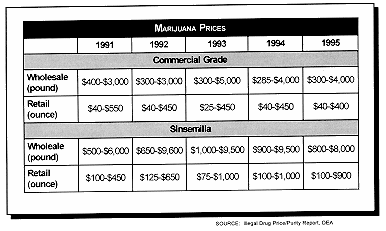Drug Enforcement Administration
Briefing Book
![]() DRCNet Response to the
DRCNet Response to the
Drug Enforcement Administration
Briefing Book
| DEA Statement | Response |
| Marijuana remains the most commonly used illicit drug in the United States, where it is readily available. The notable exception is Hawaii. Sucessful cannabis eradication efforts there forced traffickers to import large quantities of marijuana from the mainland. Marijuana from Mexican sources, whether grown in Mexico or transshipped from other nations, accounted for more than 50 percent of the foreign marijuana available in the United States during 1995. | The DEA fails to note:
|
| Marijuana is made from the Cannabis sativa L. plant, whose flowering tops and leaves are collected, trimmed, dried and then smoked in a pipe or as a cigarette. The flowering tops are prized because of their higher THC content. THC (tetrahydrocannabinol) is the plant's principal psychoactive chemical. |
Contrary to the DEA's other statements, the primary active ingredient in marijuana is sold as a prescription drug. See the Marinol Brochure. |
| Some users hollow out commercial cigars and replace the tobacco with marijuana. Such cigars are known as "blunts," and may contain as much marijuana as six typical marijuana joints. Blunt smoking is widespread throughout the United States. In 1995, cigars filled with a combination of marijuana and PCP were reported in several cities. On the West Coast, marijuana is smoked in combination with methamphetamine. | In each case, the primary health risk to the user is from the drugs that marijuana is sometimes used with. rather than marijuana itself. With alcohol and other drugs, for comparison, it is alcohol which usually poses the greatest health risk to the user. |
| During the late 1970s and early 1980s, the THC content of commercial grade marijuana averaged under 2 percent. By comparison, the average in 1995 was 3.33 percent. The average content for sinsemilla, the unpollinated flowering tops of the female plant with an inherently higher THC content, was 6.66 percent. In 1995, marijuana with a THC content of 24.22 pecent was seized in Alaska, suggesting the trend toward higher potency marijuana. |
The DEA's own figures do not support their claims elsewhere that today's
marijuana is massively more potent than the marijuana of yesteryear. The 2 percent
figure rising to 3.3 percent (over a period of 25 years) is analogous to the difference
between beer which is 2 percent alcohol and beer which is 3.3 percent alcohol.
Neither one comes close to being whiskey. The more potent varieties of marijuana have been available for hundreds of years, at least. Hashish is simply concentrated marijuana and is of such ancient origin that it is referred to in the Tales of the Arabian Nights, among other ancient literary works. Some scholars have concluded that the Old Testament also refers to hashish. See Indications of the Hashish Vice in the Old Testament. |
 |
|
| Use: According to the 1995 National Household Survey on Drug Abuse, an estimated 9.8 million Americans were current (past month) marijuana or hashish users in 1995. This represents 4.7 percent of the population aged 12 and older. Between 1994 and 1995, the rate of marijuana use among youths age 12 to 17 increased from 6 percent to 8.2 percent, continuing a trend that began during 1992-93. Since 1992, the rate of use among youth has more than doubled. | Herein lies the justification for the massive war on drugs. Without including the large numbers of otherwise law-abiding marijuana users, the small numbers of regular users of the other illegal drugs would simply not justify the massive bureaucracy and political hysteria behind the war on drugs. |
Travel back to the DRCNet Response to the DEA Home Page
Travel back to the DRCNet List of DEA Publications
Travel back to the Table of Contents